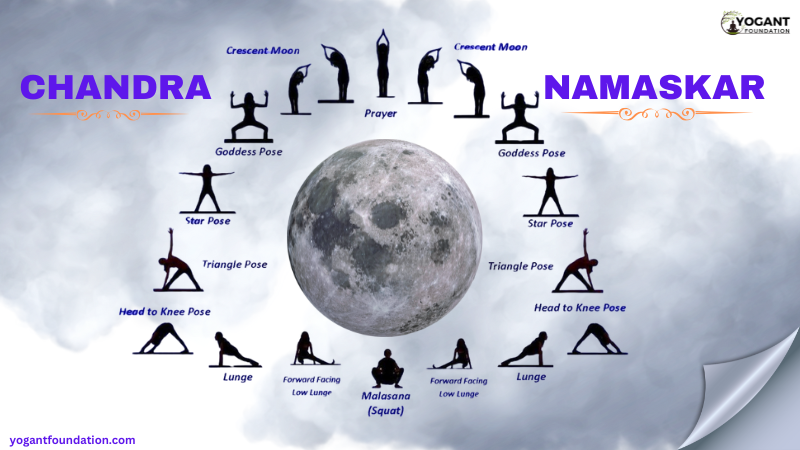Chandra Namaskar
As the day gives way to night in Rishikesh, the sky is filled with lovely orange and purple tones, and there is a soft feeling in the air. The sacred Ganges runs quietly, and the moon rises quietly as well with its gentle glow. Here at our school, situated in the lap of the Himalayas, we talk about the balance of nature and how we can find our own balance as it connects to nature’s rhythms for our own well-being. Just as the sun ignites our mornings, the moon can provide a calming and beautiful transition to our evenings: Chandra Namaskar, or Moon Salutation.
Chandra Namaskar is more than just a series of yoga asanas; it is a journey to silence, a means to pause and connect with the moon’s calm, kind, and intuitive energy. In a world that always tells us to do more, especially as our young kids do more, the lunar cycle can be really helpful.
Moonbeams in Motion: What is Chandra Namaskar?
If you are wondering what Chandra Namaskar is, then consider Chandra Namaskar to be a peaceful, meditative movement flow in honor of the moon. Through its playful counterpart Surya Namaskar and preparing your body for the day, Chandra Namaskar is about cooling down, looking inward, and inviting restful energy.
This practice sequence will move and stretch the body gently while strength can also develop, but yet, the real-life skill learned with Chandra Namaskar is calming a busy mind. Picture connecting your breath and flowing through intentional movement to create restful energy in all your being.
Benefits of Chandra Namaskar for Growing Minds
Nurturing a Calm:
Chandra Namaskar offers a warm, gentle hold of all the wonderful benefits a student can achieve. Here are a few of the benefits of Chandra Namaskar:
Assistance with Emotional Regulation & Stress Relief: Our children are living in a stressed-out world. Between school pressure and friends, there are a lot of demands placed on kids every day.
This sequence works like a salve for busy brains and is helpful at halting anxieties and letting stress go, making emotional regulation so much easier.
Improved Sleep: After the bustle of a learning day, we all know sleeping can sometimes be a bit of a challenge. This practice calms the nervous system and primes the body and mind for deeper, more restorative sleep. Hello, dreamy sleep!
Improved Flexibility & Balance: Chandra Namaskar includes gentle stretches that improve mobility and overall flexibility, which is essential for developing bodies.
This sequence also requires stability-holding postures, which improve physical balance and coordination.
Increased Intuition & Creativity: Chandra Namaskar invites stillness and encourages contemplation with silence, developing a relationship to oneself, naturally leading to creativity and intuitive awareness.
Calming Effects on the Nervous System: The practice of Chandra Namaskar enables a gentle activation of the parasympathetic nervous system, providing “rest and digest” mode, lowering heart rates, and resting deeply.
Chandra Namaskar Steps
Let’s walk through the beautiful flow of the Chandra Namaskar steps. Remember, it’s about movement and breath flowing together as one, not rigid, inflexible positions.
Pranamasana (Salutation Pose):
Start standing tall at the front of your mat with your hands pressed together at your heart center. Take a moment to set your intention for peace and calm.
Ardha Chandrasana (Half Moon Prep):
Inhale and sweep your arms overhead. As you exhale, gently bend to one side, feeling the stretch take place along your side body. Return to center for an inhale, then exhale to the other side—this little sway mirrors the crescent moon that you’re representing at this moment.
Utkata Konasana (Goddess Pose):
Step your feet out wide with toes pointing out as well. Bend your knees so your hips sink downward and keep your spine straight.
You can keep your arms in a cactus shape with your elbows bent. Feel grounded and strong like a tree with roots grounded firmly down into Mother Earth.
Trikonasana (Triangle Pose):
Straighten one leg and begin to turn your foot out, and extend your arms parallel to the floor.
As you reach your arms in either direction, reach forward and gently hinge forward from your hip as long as you can. Then rest your hand on your shin or directly on the floor with the opposite arm pointing toward the sky. Feel the expanded stretch.
Parsvakonasana (Extended Side Angle Pose):
In your Triangle, bend your front knee and place your forearm on your thigh (or place your hand on the floor outside your foot) and extend your top arm overhead.
Prasarita Padottanasana (Wide-Legged Forward Fold):
Turn both feet forward and parallel. Inhale, lengthen your spine, and exhale. Bend forward from your hips, letting your head drop heavy to release the tension from the day.
Skandasana (Side Lunge):
Bend one knee and keep the other leg straight and the foot flexed. Sink into a deep side lunge and feel the stretch in your inner thighs. This pose is incredibly grounding all the way down to the core of the Earth.
Malasana (Garland Pose, Yogi Squat):
Come to a deep squat, feet wide, and heels down if possible. Bring your hands to prayer at your heart and use your elbows to gently open your knees and your lower body.
After this you would reverse on the other side as if you are doing. The Skandasana, Prasarita Padottanasana, Parsvakonasana, Trikonasana, Utkata Konasana, and Half Moon to Pranamasana.
This mirroring creates a beautiful and cyclical energy with your body and breath. Just like the moon and all of its phases.

Sun vs. Moon: What is the Difference Between Surya Namaskar and Chandra Namaskar?
This is a question we often hear! While both are basic yoga sequences, knowing exactly what the difference is between Surya Namaskar and Chandra Namaskar. It is crucial in determining the sequence and why it is appropriate for your practice.
Energy: Surya Namaskar (Sun Salutation) is active, motivating, and heating (puts hair on your chest). It wakes you up and creates inner fire. Chandra Namaskar is cooling, calming, and receptive; it winds you down.
Pacing: Surya Namaskar is often done with a dynamic, moving pace. Chandra Namaskar is generally slower, more intentional, and less dynamic.
Focus: The Sun Salutation focuses on strength and backbends, engaging outward energy, whereas the Moon Salutation. It’s works better for stretching, forward folds, and hip opening—more inward energy.
Timing: Surya Namaskar is better in the morning to set yourself up for the day. Chandra Namaskar is better in the evening.
Think of it this way: Surya Namaskar is like your morning coffee: motivating and bright. Chandra Namaskar is like your calming herbal tea: soothing and restful.
Gentle Guidance: Who Should Not Do Chandra Namaskar?
Although Chandra Namaskar is often a milder practice. It is always best to respect your body, and it is important to consider if you have any physical limitations. So, who should not do Chandra Namaskar without caution or modifications?
Practitioners with serious knee or hip injuries: Deep squats and lunges may not be accessible. Talk to a qualified instructor to explore modifications or possible alternative poses.
Acute lower back pain—gentle stretches may be helpful, but some forward folds may increase sharp pain. Check with your medical doctor or physical therapist if pain is serious.
Recent surgery, especially abdominal, hip, or knee. Make sure you get the all clear from your doctor to begin resuming physical activity.
Pregnancy—gentle movement is good, but certain poses should be modified or avoided, like deep forward folds and deep twists that increase pressure on your belly, especially later in the pregnancy. A prenatal yoga class is even better.
As always, listen to your body. If you’re not sure, you can always ask your healthcare professional or a certified yoga instructor for help.
Tracing the Lunar Roots: Who Invented Chandra Namaskar?
What a fun piece of yoga history! While Surya Namaskar has ancient roots in Vedic traditions, Chandra Namaskar has no ancient inventor or source in the same way.
Chandra Namaskar is decidedly a modern form. In the 20th century, with the development of modern yoga and the increasing popularization of different traditions. A focus on solar energy by some yoga practitioners caused a need for a counterpart lunar practice. The urgency began to be felt to have a cooler and more introspective sequence.
While it is not easy to assign Chandra Namaskar to a single ‘inventor,’. It is common to link it to influences from schools and teachers who began to feel this need a couple of generations ago. It’s remarkable to see how a living tradition has evolved to meet the modern. Contemporary need to reach for balance and well-being.
Welcoming the Night: Can We Do Chandra Namaskar at Night?
Absolutely! Yes! In fact, is it possible to do Chandra Namaskar at night? It is not only possible but absolutely encouraged! This is the time that the practice connects closest to its name.
Ideal Wind Down: As we mentioned, its calmative nature allows you to wind down and release. The accumulated tensions of the day while transitioning your body for rest and your mind for sleep.
Align with the Moon’s Energy: Practicing our sequence under the moon’s energy (or just in the quiet evening!) helps with the moon’s slow, cool touch and intuitiveness. It is a beautiful time to reflect on your day and set an intention for a restful night.
Pre-Sleep Routine: Including just a few rounds of Chandra Namaskar in your nightly routine can improve sleep and transition your mind into a restful space, making your way into dreamland.
It is beautiful to imagine doing this flow under the glow of the moon, perhaps with the stars above the quiet Rishikesh landscape. This is truly nourishing for the soul.
At our school, we are committed to nurturing the whole child—body, mind, and spirit. Chandra Namaskar provides a strong yet gentle way to find inner peace and balance and is an invaluable resource as a tool to navigate the journey of life. We encourage you to explore this peaceful practice and find your own calming support of the moon. Join us, and allow the lunar lullaby to blues you to a more peaceful and balanced path.



